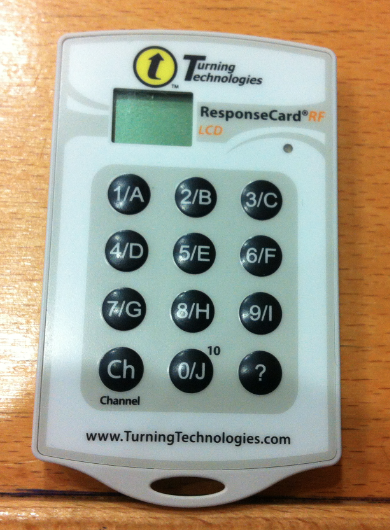
Clickers
Remember my ABCD voting cards? Here is how the professionals do audience response.
Remember my post on ABCD voting cards (post 1, 2, 3 on the topic)?
I then introduced them as “low tech clickers”. Having never worked with actual clickers then, I really really liked the method. And I still think it’s a neat way of including and activating a larger group if you don’t have clickers available. But now that I have worked with actual clickers, I really can’t imagine going back to the paper version.
So what makes clicker that much better than voting cards?
Firstly – students are truly anonymous. With voting cards nobody but the instructor sees what students picked. But having the instructor see what you pick is still a big threshold. And to be honest – as the instructor, you do tend to remember where the correct answers are typically to be found, so it is totally fair that students hesitate to vote with voting cards.
Secondly – even though you as the instructor tend to get a visual impression of what the distribution of answers looked like, this is only a visual impression. The clicker software, however, keeps track of all the answers, so you can go back after your lecture and check the distributions. You can even go back a year later and compare cohorts. No such thing is possible with the voting cards unless you put in a huge effort and a lot of time.
Third – the distribution can be visualized in real time for the students to see. While with the voting cards I always tried to tell the students what I saw, this is not the same thing as seeing a bar diagram pop up and seeing that you are one out of two students who picked this one option.
If you read German – go here for inspiration. My colleague is great with all things clicker and I have learned so much from him! Most importantly (and I wish I had known this back when I used the voting cards): ALWAYS INCLUDE THE “I DON’T KNOW” OPTION. Especially when you make students to pick an answer (as I used to do) – if you don’t give them the “I don’t know” option, all you do is force them to guess, and that can really screw up your distribution as I recently found out. But more about that later…
P.S.: If I convinced you and you are now looking for alternatives to paper voting cards but can’t afford to buy a clicker system – don’t despair. I might write a post about it alternative solutions at some point, but if you want to get a couple of pointers before that post is up, just shoot me an email…

Testing drives learning. | says:
[…] way to include more testing in large classes are clickers and multiple choice questions, and the benefits of clickers on retention of material are discussed […]
Does multitasking hurt learning? Show ’em! | says:
[…] talking explicitly about the Ellis et al. paper, re-do this experiment with your class! In times of clickers in most (many? some?) classrooms and online-testing as abundant as it is, doing this for a class […]
Development of student attention over time | Adventures in Oceanography and Teaching says:
[…] during class? The main thing seems to be to change activities regularly. For example introduce clicker questions or show demonstrations (but then don’t forget the peer instruction phases before and […]